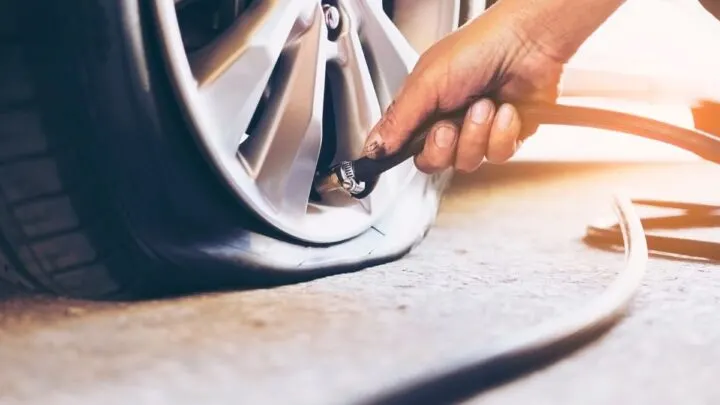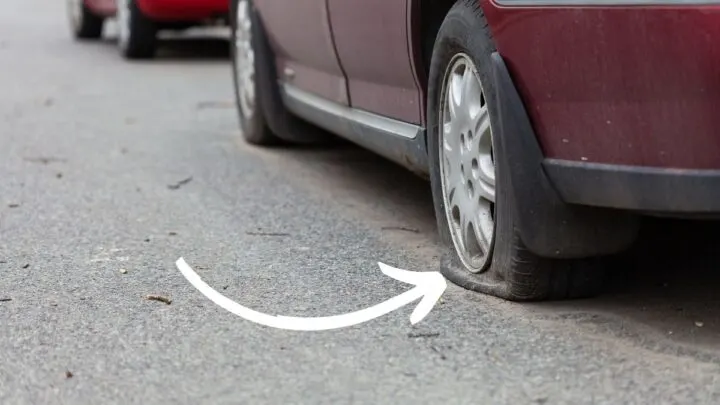Sometimes, drivers don’t have a choice except to drive on a flat tire, depending on if it blows out when they’re too far from a mechanic’s shop. However, it can have devastating effects on their vehicles’ tires and rims.
However, there have been criminals or law enforcement officers involved in high-speed chases with one or more flat tires, which leaves us to speculate how safe it really is.
Furthermore, how far can you drive on a flat tire? Can you even really drive on a flat tire at all?
You can drive on a flat tire for several hundred yards before damaging it and eventually damaging the rim. Pull over immediately when you notice that your car is difficult to steer, there’s excessive vibration on the steering wheel, or you hear a loud noise from the wheels.
Once you’ve identified the flat tire, slow down and pull over to the side of the road. Don’t stop your vehicle in the middle of the lane, as you will risk your life along with other road users.
Today’s article covers how long you can drive on a flat tire, what to do if you get one, and the differences between flat and low-pressure tires.
How Far Can You Drive on a Flat Tire?
Driving on a flat tire is very dangerous and costly. In most cases, and depending on the road conditions, you can only drive for a few hundred yards on a flat tire before you damage it.
However, if you’re not in a safe area or can’t stop, it’s better to drive on a flat tire and spend some money replacing the wheel or rims than risking your own life.
However, you’ll need to drive at less than 20 miles per hour and be very vigilant for potholes and debris on the road.
How Long Can You Drive on a Flat Tire?
The distance and duration you’ll spend driving on a flat tire depends on your tire’s condition, the weight of your vehicle, and the road conditions.
Regardless, it would help if you didn’t drive on a flat tire at all, as you’ll start damaging it within a couple of meters.
If you drive for several miles, you’ll damage the rims quite badly. And, always remember that rubber is cheaper than metal.
Therefore, unless it’s a matter of life and death, try not to drive on a flat tire at all.
What’s the Difference Between Low Tire Pressure and a Flat Tire?
1. Low-Pressure Tire
A low pressure/ underinflated tire has less than recommended air pressure. It may be due to the tire’s underinflation or due to a slow puncture.
Underinflating your tires improves the traction and grip necessary for acceleration, braking, and cornering. However, you’ll end up wearing out the tire faster!
2. A Flat Tire
On the other hand, a flat tire is one that has lost all or most of its air, causing the car to ride on the tire tread.
Vehicles with one or more flat tires are difficult to steer, more prone to lose control, and cause immense damage to the tires and rims.
Signs That Your Tire Is Going Flat
Unless it results from an object from the road, most punctures affect worn-out tires. Here are signs that you’re running on a flat tire.
Difficulty Steering
Tire punctures more commonly result in slow leaks rather than a full tire blowout, making them harder to notice. And, usually, by the time you notice it, your car will be running on a flat tire.
The car will be hard to steer and will often change its trajectory towards the punctured wheel’s side. If you experience the dragging feeling, it’s safer to pull aside and replace or repair the flat tire.
Excessive Steering Wheel Vibrations
The advancement in vehicle suspensions means that you might not feel the car or wheel vibrating until the tire is completely flat.
If this is the case, you’ll feel your steering wheel start to shake, followed by a loud flapping sound from the flat tire.
Leaking or Popping Sound From the Wheels
A leaking sound from your tires indicates that your car has a puncture and will be flat in no time.
If you hear the popping sound, it’s safer if you stop at the nearest auto repair shop so that you can repair it before it gets worse.
Better Acceleration
Flat tires have wider surfaces that are in contact with the road, improving traction and acceleration.
If you find that your car suddenly accelerates better than usual, it might be because of a low-pressure or flat tire.
However, you’ll immediately find it difficult to steer despite the enhanced acceleration, and your car might have a different feel while go around a corner or changing lanes.

What to Do if You Get a Flat Tire
How you’ll respond to your car having a flat tire will depend on whether it’s stationary or in motion.
When it’s parked or if you’re stopped at a light or stop sign, it’s much easier and safer to replace the tire than when on the road.
However, it all depends on your location, how good you are at changing the tire, whether you can fix it, and whether you have a spare tire with you.
When Your Car Is Parked
Do a Thorough Tire Inspection
When planning for a commute to work or a road trip, it’s crucial to check your vehicle’s tire pressures.
If you can tell that one or more of the tires has less than recommended pressure, you should start by inspecting them for any foreign objects.
The objects are mostly sharp screws, nails, sharp stones, or broken glass. These can be commonly found on some roads due to many drivers and accidents being on them. If you don’t find any object, your tire may be low on air or have a slow puncture.
And, since it’s difficult to differentiate between the two, it’s safer if you get your car to an auto repair shop for repair either way.
Use a Spare Tire
Nowadays, spare tires are smaller and occupy less space than full-sized spare tires. On the downside, they’re not suitable for long-distance travel and may only serve you for several miles.
A spare tire is very important, especially when you’re in a hurry or don’t have the necessary tools to fix your vehicle’s tire. It enables you to get to a repair shop before continuing on.
However, the low profile tire won’t offer the same traction and braking as the remaining three tires. As a result, it’s only recommended to drive about 50 miles an hour if you’re driving on a low profile spare tire.
When Driving
Having your tires in good condition while driving will save you a lot of stress in the long run. Remember that front tires will wear out faster than the back tires since they bear a lot of steering and braking stress.
But it doesn’t mean that they’re more susceptible to punctures when on the road. If you’re driving, and you notice that one of your tires is flat or has low pressure, here’s what you should do.
Pull Over Immediately if You’re in a Safe Location
If you’re in a safe location, bring your car to a stop by gradually pressing the brake pedal.
Slamming the brakes on a flat tire is dangerous, and you might lose control of your vehicle. Furthermore, ensure that your vehicle is completely on the shoulder to have enough room to inspect it without risking being hit.
Replace the Flat Tire With a Spare One
Replacing your flat tire with a spare one is much easier and faster than repairing it on the roadside. Additionally, if you have a lot of time to spare, you can opt to repair the puncture.
However, tires can get punctured in several sections so identifying them becomes a challenge. And from experience, a spare wheel is the best option when you’re in a hurry.

Tips for Avoiding Flat Tires
Here are some measures you can take to significantly prevent your tires from going flat unexpectedly.
- Buy good quality tires.
- Invest in quality brakes to prevent uneven wearing of the tires.
- Check the tire pressure regularly.
- Install run-flat tires.
- Don’t overload your vehicle.
- Rotate your tires every 60,000 to 80,000 miles.
- Be cautious while driving.
Frequently Asked Questions (FAQs)
How Long Can You Drive on a Tire With Fix-a-Flat?
You can drive on a tire with fix-a-flat for a distance of 100 miles or 3 days, whichever comes first.
How Long Can You Drive on a Run-Flat?
The number of miles or speed that run-flat tires can accommodate varies with the manufacturer, but generally range from 25 to 200 miles.
For example, Bridgestone run-flat tires allow you to drive on empty tires for up to 50 miles at a maximum speed of 50 miles per hour.
Conclusion to Driving on Flat Tires
For the most part, unless it’s dangerous for you to do so, you should not be driving on a flat tire at all. The first thing to do it to pull over or take the car to a repair shop.
If you have to drive on a flat tire, only do so until it’s safe to stop.
